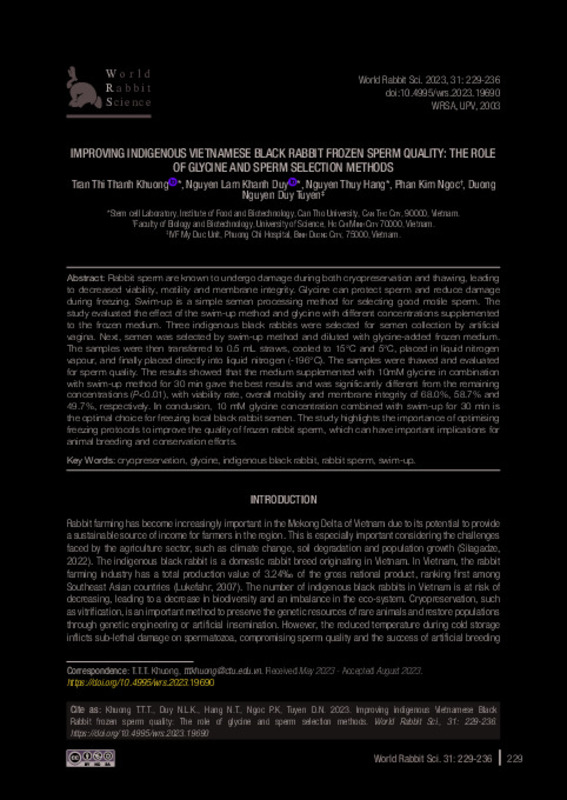JavaScript is disabled for your browser. Some features of this site may not work without it.
Buscar en RiuNet
Listar
Mi cuenta
Estadísticas
Ayuda RiuNet
Admin. UPV
Improving indigenous Vietnamese Black Rabbit frozen sperm quality: the role of glycine and sperm selection methods
Mostrar el registro sencillo del ítem
Ficheros en el ítem
| dc.contributor.author | Tran, Thi-Thanh Khuong
|
es_ES |
| dc.contributor.author | Duy, Nguyen Lam Khanh
|
es_ES |
| dc.contributor.author | Hang, Nguyen Thuy
|
es_ES |
| dc.contributor.author | Ngoc, Phan Kim
|
es_ES |
| dc.contributor.author | Tuyen, Duong Nguyen Duy
|
es_ES |
| dc.date.accessioned | 2024-01-04T08:49:39Z | |
| dc.date.available | 2024-01-04T08:49:39Z | |
| dc.date.issued | 2023-12-27 | |
| dc.identifier.issn | 1257-5011 | |
| dc.identifier.uri | http://hdl.handle.net/10251/201459 | |
| dc.description.abstract | [EN] Rabbit sperm are known to undergo damage during both cryopreservation and thawing, leading to decreased viability, motility and membrane integrity. Glycine can protect sperm and reduce damage during freezing. Swim-up is a simple semen processing method for selecting good motile sperm. The study evaluated the effect of the swim-up method and glycine with different concentrations supplemented to the frozen medium. Three indigenous black rabbits were selected for semen collection by artificial vagina. Next, semen was selected by swim-up method and diluted with glycine-added frozen medium. The samples were then transferred to 0.5 mL straws, cooled to 15°C and 5°C, placed in liquid nitrogen vapour, and finally placed directly into liquid nitrogen (-196°C). The samples were thawed and evaluated for sperm quality. The results showed that the medium supplemented with 10mM glycine in combination with swim-up method for 30 min gave the best results and was significantly different from the remaining concentrations (P<0.01), with viability rate, overall mobility and membrane integrity of 68.0%, 58.7% and 49.7%, respectively. In conclusion, 10 mM glycine concentration combined with swim-up for 30 min is the optimal choice for freezing local black rabbit semen. The study highlights the importance of optimising freezing protocols to improve the quality of frozen rabbit sperm, which can have important implications for animal breeding and conservation efforts. | es_ES |
| dc.description.sponsorship | This study is funded in part by the Can Tho University, Code: T2022-133 | es_ES |
| dc.language | Inglés | es_ES |
| dc.publisher | Universitat Politècnica de València | es_ES |
| dc.relation.ispartof | World Rabbit Science | es_ES |
| dc.rights | Reconocimiento - No comercial - Compartir igual (by-nc-sa) | es_ES |
| dc.subject | Cryopreservation | es_ES |
| dc.subject | Glycine | es_ES |
| dc.subject | Indigenous black rabbit | es_ES |
| dc.subject | Rabbit sperm | es_ES |
| dc.subject | Swim-up | es_ES |
| dc.title | Improving indigenous Vietnamese Black Rabbit frozen sperm quality: the role of glycine and sperm selection methods | es_ES |
| dc.type | Artículo | es_ES |
| dc.identifier.doi | 10.4995/wrs.2023.19690 | |
| dc.relation.projectID | info:eu-repo/grantAgreement/Can Tho University//T2022-133 | es_ES |
| dc.rights.accessRights | Abierto | es_ES |
| dc.description.bibliographicCitation | Tran, TTT.; Duy, NLK.; Hang, NT.; Ngoc, PK.; Tuyen, DND. (2023). Improving indigenous Vietnamese Black Rabbit frozen sperm quality: the role of glycine and sperm selection methods. World Rabbit Science. 31(4):229-236. https://doi.org/10.4995/wrs.2023.19690 | es_ES |
| dc.description.accrualMethod | OJS | es_ES |
| dc.relation.publisherversion | https://doi.org/10.4995/wrs.2023.19690 | es_ES |
| dc.description.upvformatpinicio | 229 | es_ES |
| dc.description.upvformatpfin | 236 | es_ES |
| dc.type.version | info:eu-repo/semantics/publishedVersion | es_ES |
| dc.description.volume | 31 | es_ES |
| dc.description.issue | 4 | es_ES |
| dc.identifier.eissn | 1989-8886 | |
| dc.relation.pasarela | OJS\19690 | es_ES |
| dc.contributor.funder | Can Tho University | es_ES |








